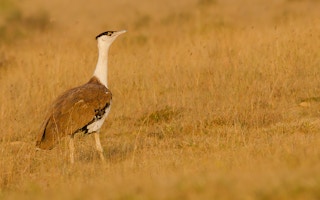India’s relentless pursuit of a stated goal of producing 450 gigawatts of renewable energy by 2030 may be taking a toll on endangered bird populations, a study suggests.
The study highlighted bird mortalities, especially that of the highly endangered great Indian bustard (Ardeotis nigriceps), resulting from contact with power lines in the Thar Desert. A renewable energy hub, the Thar supports 14 threatened and 65 migratory species that populate the Central Asian Flyway, a geographical corridor used by migratory birds.
Concentrating on an area spanning over 42,000 square kilometres of the Jaisalmer district of Rajasthan state, the study found that wind turbines and solar farms have, over the last decade, spawned 1,700 kilometres of power lines criss-crossing the desert.
According to the study, the Thar Desert represents a conflict between electricity supply and conservation. “Arid ecosystems of India, marginalised as wastelands, are used for renewable energy production resulting in rapid expansion of overhead wires. Since renewable power is considered as ecologically benevolent, its expansion has been facilitated by leniency in environmental clearances,” the study said.
“
The great Indian bustard will, without doubt, be one of the first large species to go extinct in modern India. It is an irony that this extinction is being accelerated by green infrastructure.
Abi Tamim Vanak, associate professor, Centre for Biodiversity and Conservation
Large-bodied birds such as the great Indian bustard, a resident of the Thar Desert, are particularly vulnerable to power line collisions due to narrow frontal vision and heavy flight, says the study which estimates about 88,000 birds die each year in the area surveyed.
“The population viability analysis revealed that the Great Indian Bustard is at imminent risk of extinction due to power line mortality,” the study said.
Yadvendradev Jhala, one of the authors of the study, says that burying cables in certain locations is the best solution, adding that it is technically feasible. “All other cables need to be fitted with bird diverters on all conductors within bustard habitats,” he tells SciDev.Net.
The great Indian bustard, one of the largest flying birds in the world, is protected under India’s Wildlife Protection Act of 1972. According to the Wildlife Institute of India, bustards are critically endangered and nearing extinction with their current population estimated at 150 individuals, most of that number concentrated in the Thar.
Abi Tamim Vanak, at the Centre for Biodiversity and Conservation, Ashoka Trust for Research in Ecology and the Environment (ATREE), Bangalore, India, says: “This is an excellent study that, perhaps for the first time in India, comprehensively examines bias-corrected avian mortality due to high-tension power lines. The study estimates a mind-boggling collision mortality of 51 birds per kilometre of power lines per year.”
Vanak says that the Thar desert is being touted as the renewable energy powerhouse of India. “But, this study comprehensively shows that there is nothing green about this energy, especially when it comes at the cost of critically endangered species,” he adds.
“The great Indian bustard will, without doubt, be one of the first large species to go extinct in modern India. It is an irony that this extinction is being accelerated by green infrastructure.”
T. Ganesh, senior fellow at ATREE’s Suri Sehgal Centre for Biodiversity and Conservation, says that the study has demonstrated the negative effects of high-tension power lines on birds using rigorous science and extensive fieldwork. “It’s quite revealing that even small birds are affected by these structures.”
“The Thar Desert is an open ecosystem and any structure that comes up is a hindrance to wildlife adapted to the area. Many migratory species that stay or fly over the Thar are adapted to such ecosystems and conditions and therefore it’s not surprising that mortality is high when they arrive in India each October,” Ganesh tells SciDev.Net.
Ganesh recommends burying the cables in the desert. “This, done in consultation with other organisations and stakeholders of the region, could be our last hope to save our bustards,” he adds.
M. K. Ranjitsinh, a leading conservationist, says that the study is proof that immediate measures are needed for conserving endangered birds. “If the great Indian bustard goes extinct, it will be deemed that it was not only allowed to go extinct, but it was made extinct,” he says.
This article was originally published on SciDev.Net. Read the original article.








